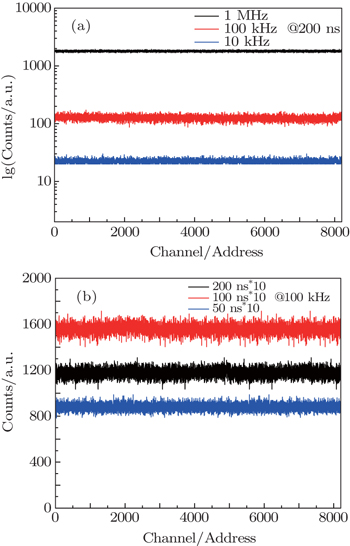† Corresponding author. E-mail:
Project supported by the National Natural Science Foundation of China (Grant Nos. 61178010 and 11374042), the Fund of State Key Laboratory of Information Photonics and Optical Communications (Beijing University of Posts and Telecommunications), China, and the Fundamental Research Funds for the Central Universities of China (Grant No. bupt2014TS01).
This paper proposes a well-performing hybrid-type truly quantum random number generator based on the time interval between two independent single-photon detection signals, which is practical and intuitive, and generates the initial random number sources from a combination of multiple existing random number sources. A time-to-amplitude converter and multichannel analyzer are used for qualitative analysis to demonstrate that each and every step is random. Furthermore, a carefully designed data acquisition system is used to obtain a high-quality random sequence. Our scheme is simple and proves that the random number bit rate can be dramatically increased to satisfy practical requirements.
Random numbers play an important role in many fields, such as statistical analysis, computer simulations, cryptography,[1] and quantum key distribution (QKD).[2] Traditionally, there are two different types of random number generators: pseudo random number generators (PRNGs) and true random number generators (TRNGs). Pseudo random number generators require an initial seed as an input, which means that the underlying mathematical algorithm is deterministic. Additionally, as the entropy depends on the length of the random seed, the pseudo random number is not truly random, which limits the actual applications for PRNGs.[1]
On the other hand, TRNGs use a random sequence which is based on fundamental physical processes, such as a chaotic physical process,[3,4] a quantum physical process,[5,6] air turbulence,[7] radioactive decay,[8] and random phases.[9] The indeterministic laws of physics make the output sequences of a random number generator virtually impossible to predict.
In recent years, the probabilistic nature of the quantum physical process is utilized to construct quantum random number generators (QRNGs) whose output is unpredictable. For instance, beam splitter schemes are realized by measuring the path selection of single photons arriving at a 50/50 beam splitter (BS).[10] The bit rate is another important factor that is exploited to produce high-efficiency QRNGs. Those schemes include vacuum state fluctuations[11,12] and quantum phase fluctuations,[13,14] and so far, the fastest TRNGs scheme has already reached 68 Gbps,[14] which is based on quantum phase fluctuations.
Another natural method to achieve QRNGs is based on the random distribution of the time interval between photons emitted from a single-photon-like source.[6,15–17] Many current designs based on the arrival time have demonstrated outstanding results.[18–21] Our group has invested significant effort to overcome some of the limitations of our previous approach.[17] However, there are still some drawbacks, such as instability, insufficient coding efficiency, a low random bit rate, and a faulty experimental setup.
Furthermore, most of the QRNG schemes that already exist are based on only one random number source.[9] In those schemes, the properties of the random number source establish the quality of the random number generation. However, it is quite difficult to obtain a satisfactory random number sequence. Additionally, in order to achieve a high-efficiency QRNG, post-processing becomes increasingly complex.[22] Therefore, it is difficult to make significant improvements to QRNGs with a single random number source. However, another method that can be used is to merge several independent random number sequences, which may already exist as low-efficiency sequences. This makes a high-efficiency QRNG available without requiring complicated processing.
In this paper, we present a hybrid QRNG scheme which combines multiple random number sources. These sources are based on the time of arrival of single photons. Compared with previous studies based on arrival time, the proof-of-concept experiments show that our scheme is simple with a well-performing random nature. It is also practical and fast.
The schematic setup is shown in Fig.
In the first experimental demonstration, the distribution of the time interval of the photons is observed. Figure
The data stream from the TAC flowing into the MCA is schematically shown in Fig.
Experiments show that the frequencies of SPD and the full-scale time limit (FSTL) of the TAC are the two elements which have the largest effect on the count rate. A diagram for each channel is shown in Fig.
 | Fig. 4. (a) The counts at different frequencies while the TAC’s FSTL is 200 ns. (b) Number of photons for different FSTL values of the TAC when the SPD frequency is 100 kHz. |
Another way to achieve higher bit rate is to design a high-efficiency coding system. Hence, we carefully coded the data based on the channels where each single output of the TAC was located. As shown in Fig.
This is equivalent to

Here m represents the sum over all channels. In our scheme, the variable m is set to 8192, so the variable n must be less than 13. The channels can then be divided into k = m/23 parts. For each part, the coding scheme is the same as shown in Fig.
For the variable n, practical requirements determine its suitability. In Fig.
The raw random bits from our QRNG are contributed by both the quantum signal and the classical noise. In order to guarantee that the generated random number is only quantum, the effect of classical noise is also analyzed.
As demonstrated above, the QRNG system which is based on combining multiple random number sources is very stable. Additionally, it can be intuitively observed that the randomness of the raw data is excellent. In order to test the randomness of the raw data, we employed an ENT statistical test suite.[23] Approximately 10 Gbit of raw data were passed through the ENT tests. One set of results is shown in Table
| Table 1. The standard statistical test of ENT. For each scheme, more than 10 Gbit of raw data were tested with the parameter n set to 3. The raw data sequence at three different frequencies corresponds to the data shown in Fig. |
In summary, we have designed a scheme for a hybrid random number generator based on the arrival time of photons, which combines multiple random number sources. We have experimentally verified the randomness of the sequences for every step. Compared to our previous QRNG design, which was based on time intervals, the randomness has improved dramatically and the random sequence is almost uniformly distributed. Moreover, with the help of MCA and ENT methods, the scheme has been tested both qualitatively and quantitatively. With the utilization of multiple random number sources, our schemes demonstrate excellent efficiency, which makes QRNG suitable for various circumstances. More importantly, by using a hybrid-type scheme, existing low-efficiency schemes can be profitably used to generate high-efficiency QRNGs.
| 1 | |
| 2 | |
| 3 | |
| 4 | |
| 5 | |
| 6 | |
| 7 | |
| 8 | |
| 9 | |
| 10 | |
| 11 | |
| 12 | |
| 13 | |
| 14 | |
| 15 | |
| 16 | |
| 17 | |
| 18 | |
| 19 | |
| 20 | |
| 21 | |
| 22 | |
| 23 |






